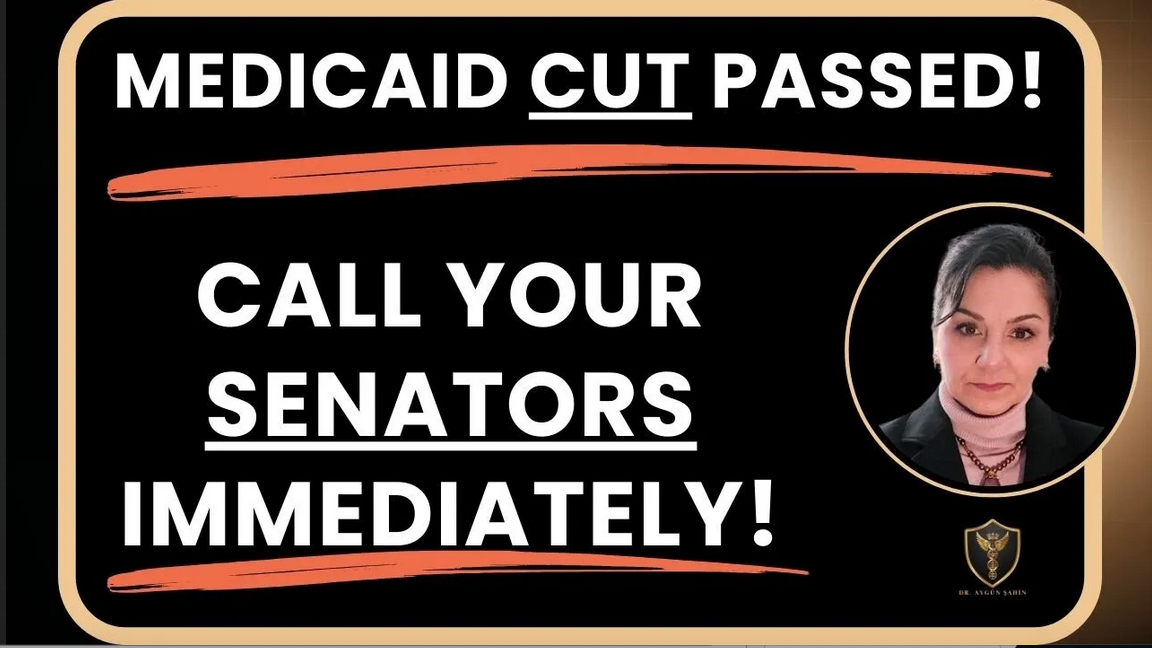House Passes H.Con. Resolution 14: What It Means for Medicaid and Your Healthcare
The U.S. House of Representatives has passed H.Con. Resolution 14, a budget resolution that outlines federal healthcare spending priorities for the next decade. A major focus of this resolution is Medicaid, a critical program that provides healthcare coverage to over 70 million low-income Americans, including seniors, children, pregnant women, and people with disabilities.
This resolution sets Medicaid's budget at $854.6 billion in 2025, but what does this mean in practical terms? How will the money be distributed, and what changes could this bring? Let's break it down in plain language so you can understand how this decision might impact healthcare services, eligibility, and access for millions of Americans.
This resolution sets Medicaid's budget at $854.6 billion in 2025, but what does this mean in practical terms? How will the money be distributed, and what changes could this bring? Let's break it down in plain language so you can understand how this decision might impact healthcare services, eligibility, and access for millions of Americans.
What Is Function 550 and Why Does It Matter?
In federal budgeting, healthcare spending falls under Function 550, which includes:
 Medicaid ($854.6 billion in 2025 funding) – Provides healthcare coverage to low-income individuals and families
Medicaid ($854.6 billion in 2025 funding) – Provides healthcare coverage to low-income individuals and families
 The Children's Health Insurance Program (CHIP) – Covers children in low-income families who don’t qualify for Medicaid
The Children's Health Insurance Program (CHIP) – Covers children in low-income families who don’t qualify for Medicaid
 Health Insurance Marketplace subsidies – Helps lower-income Americans afford private health plans under the Affordable Care Act (ACA)
Health Insurance Marketplace subsidies – Helps lower-income Americans afford private health plans under the Affordable Care Act (ACA)
 Centers for Disease Control and Prevention (CDC) – Supports disease prevention and public health programs
Centers for Disease Control and Prevention (CDC) – Supports disease prevention and public health programs
 Indian Health Service (IHS) – Provides healthcare for Native American communities
Indian Health Service (IHS) – Provides healthcare for Native American communities
 Food and Drug Administration (FDA) – Regulates food, drugs, and medical devices for safety
Food and Drug Administration (FDA) – Regulates food, drugs, and medical devices for safety
 Occupational Safety and Health Administration (OSHA) – Ensures workplace health and safety
Occupational Safety and Health Administration (OSHA) – Ensures workplace health and safety
Most of these programs are funded through mandatory spending, meaning the government must fund them by law. However, the new resolution proposes changes in how Medicaid funds are allocated, which could affect healthcare services for millions.
 Medicaid ($854.6 billion in 2025 funding) – Provides healthcare coverage to low-income individuals and families
Medicaid ($854.6 billion in 2025 funding) – Provides healthcare coverage to low-income individuals and families The Children's Health Insurance Program (CHIP) – Covers children in low-income families who don’t qualify for Medicaid
The Children's Health Insurance Program (CHIP) – Covers children in low-income families who don’t qualify for Medicaid Health Insurance Marketplace subsidies – Helps lower-income Americans afford private health plans under the Affordable Care Act (ACA)
Health Insurance Marketplace subsidies – Helps lower-income Americans afford private health plans under the Affordable Care Act (ACA) Centers for Disease Control and Prevention (CDC) – Supports disease prevention and public health programs
Centers for Disease Control and Prevention (CDC) – Supports disease prevention and public health programs Indian Health Service (IHS) – Provides healthcare for Native American communities
Indian Health Service (IHS) – Provides healthcare for Native American communities Food and Drug Administration (FDA) – Regulates food, drugs, and medical devices for safety
Food and Drug Administration (FDA) – Regulates food, drugs, and medical devices for safety Occupational Safety and Health Administration (OSHA) – Ensures workplace health and safety
Occupational Safety and Health Administration (OSHA) – Ensures workplace health and safetyMost of these programs are funded through mandatory spending, meaning the government must fund them by law. However, the new resolution proposes changes in how Medicaid funds are allocated, which could affect healthcare services for millions.
Breakdown of Medicaid Funding in H.Con. Resolution 14
In fiscal year 2025, the budget resolution allocates:
● $945.1 billion in total healthcare spending
● $854.6 billion for Medicaid and other mandatory programs
● $90.5 billion for discretionary health programs, including CDC, FDA, and OSHA
● $11.3 trillion in total healthcare spending projected over the next decade
The resolution emphasizes controlling spending growth and reducing reliance on federal funding for Medicaid, which could signal potential restrictions or changes to how states receive Medicaid dollars.
● $945.1 billion in total healthcare spending
● $854.6 billion for Medicaid and other mandatory programs
● $90.5 billion for discretionary health programs, including CDC, FDA, and OSHA
● $11.3 trillion in total healthcare spending projected over the next decade
The resolution emphasizes controlling spending growth and reducing reliance on federal funding for Medicaid, which could signal potential restrictions or changes to how states receive Medicaid dollars.
What Changes Could This Bring to Medicaid?
① Shifting More Costs to States
② Block Grants and Per-Capita Caps
● There has been talk of changing Medicaid funding to block grants or per-capita caps, meaning each state would receive a fixed amount of money instead of funding based on actual needs.
● This could lead to funding shortages if healthcare costs rise (e.g., during economic downturns or pandemics).
● People in states with higher healthcare costs could face reduced coverage or fewer services.
● This could lead to funding shortages if healthcare costs rise (e.g., during economic downturns or pandemics).
● People in states with higher healthcare costs could face reduced coverage or fewer services.
③ Work Requirements and Stricter Eligibility Rules
● Some policymakers have suggested adding work requirements for Medicaid beneficiaries.
● This means some adults would have to prove they are working, looking for work, or enrolled in job training to keep their Medicaid coverage.
● Past attempts at work requirements have led to thousands losing coverage, particularly in states that tested these policies.
● This means some adults would have to prove they are working, looking for work, or enrolled in job training to keep their Medicaid coverage.
● Past attempts at work requirements have led to thousands losing coverage, particularly in states that tested these policies.
④ Impact on CHIP (Children’s Health Insurance Program)
● CHIP funding is closely tied to Medicaid—if Medicaid funding is cut, CHIP could also face reductions.
● Millions of low-income children rely on CHIP for vaccines, doctor visits, and emergency care.
● Millions of low-income children rely on CHIP for vaccines, doctor visits, and emergency care.
Where Will the Money Go?
Under this budget resolution, Medicaid and other healthcare programs are allocated $11.3 trillion over the next decade. However, the distribution of funds may shift:
● More money may be directed toward cost-saving measures rather than expanding healthcare access.
● Medicaid expansion states could receive less federal funding over time, impacting states that expanded coverage under the Affordable Care Act (ACA).
● Certain public health initiatives, such as mental health programs and rural health funding, might face funding limitations.
The resolution’s language emphasizes "placing the emphasis on real Americans’ health needs," but critics argue that this could be used to justify cuts to federal Medicaid support in favor of state-led management.
● More money may be directed toward cost-saving measures rather than expanding healthcare access.
● Medicaid expansion states could receive less federal funding over time, impacting states that expanded coverage under the Affordable Care Act (ACA).
● Certain public health initiatives, such as mental health programs and rural health funding, might face funding limitations.
The resolution’s language emphasizes "placing the emphasis on real Americans’ health needs," but critics argue that this could be used to justify cuts to federal Medicaid support in favor of state-led management.
What Does This Mean for You?
☞ If You’re on Medicaid:
● Your eligibility and access to care could change depending on how states adjust to potential funding shifts.
● You may need to check if your state alters Medicaid services or requirements.
● Your eligibility and access to care could change depending on how states adjust to potential funding shifts.
● You may need to check if your state alters Medicaid services or requirements.
☞ If You’re a Senior or Have a Disability:
● Medicaid pays for long-term care, including nursing homes and home-based services.
● Funding changes could impact the availability of home care workers and long-term care beds.
● Medicaid pays for long-term care, including nursing homes and home-based services.
● Funding changes could impact the availability of home care workers and long-term care beds.
☞ If You’re a Parent:
● CHIP funding is closely tied to Medicaid—if Medicaid funding is reduced, children’s healthcare access could be affected.
● CHIP funding is closely tied to Medicaid—if Medicaid funding is reduced, children’s healthcare access could be affected.
☞ If You’re a Healthcare Provider:
● Hospitals, especially those in rural or low-income areas, rely heavily on Medicaid payments.
● Funding cuts could lead to service reductions or hospital closures.
● Hospitals, especially those in rural or low-income areas, rely heavily on Medicaid payments.
● Funding cuts could lead to service reductions or hospital closures.
What Happens Next?
This resolution is not yet law. The Senate must also approve it, and there will likely be negotiations and changes. However, it sets the tone for upcoming healthcare funding debates, particularly regarding Medicaid.
Key Takeaway: Medicaid is not being immediately cut, but the resolution opens the door for potential changes in funding, eligibility, and service availability.
Key Takeaway: Medicaid is not being immediately cut, but the resolution opens the door for potential changes in funding, eligibility, and service availability.
What Can You Do?
 Stay informed – Follow updates on Medicaid funding and healthcare policy.
Stay informed – Follow updates on Medicaid funding and healthcare policy. Contact your representatives – Let them know how important Medicaid is for your community.
Contact your representatives – Let them know how important Medicaid is for your community. Advocate for healthcare access – Support organizations that fight for Medicaid protection.
Advocate for healthcare access – Support organizations that fight for Medicaid protection.Final Thoughts: A Watchful Eye on Healthcare Access
H.Con. Resolution 14 signals a potential shift in Medicaid funding that could impact millions of Americans, especially vulnerable populations. While no immediate cuts have been made, the resolution sets the stage for possible reductions in federal Medicaid support, leaving states to fill the gaps.
As this budget process unfolds, it is crucial to stay engaged and make your voice heard to ensure that Medicaid remains a strong safety net for those who need it most.
As this budget process unfolds, it is crucial to stay engaged and make your voice heard to ensure that Medicaid remains a strong safety net for those who need it most.
Do you think this resolution protects or threatens Medicaid? Let’s discuss in the comments!

